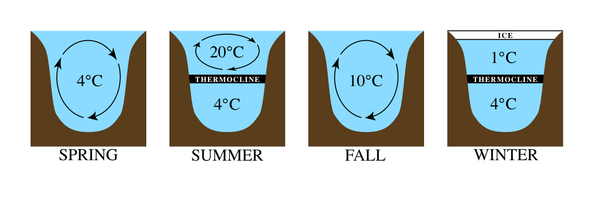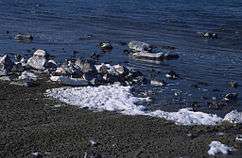Meromictic lake

A meromictic lake has layers of water that do not intermix.[1] In ordinary, "holomictic" lakes, at least once each year, there is a physical mixing of the surface and the deep waters.[2]
The term "meromictic" was coined by the Austrian Ingo Findenegg in 1935, apparently based on the older word "holomictic". The concepts and terminology used in describing meromictic lakes were essentially complete following some additions by G. Evelyn Hutchinson in 1937.[3][4][5]
Characteristics

Most lakes are holomictic; that is, at least once per year, physical mixing occurs between the surface and the deep waters. In so-called monomictic lakes, the mixing occurs once per year; in dimictic lakes, the mixing occurs twice a year (typically spring and autumn), and in polymictic lakes, the mixing occurs several times a year. In meromictic lakes, however, the layers of the lake water can remain unmixed for years, decades, or centuries.
Meromictic lakes can usually be divided into three sections or layers. The bottom layer is known as the monimolimnion; the waters in this portion of the lake circulate little, and are generally hypoxic and saltier than the rest of the lake. The top layer is called the mixolimnion, and essentially behaves like a holomictic lake. The area in between is referred to as the chemocline.[6]
The lack of mixing between layers creates radically different environments for organisms to live in: among the consequences of this stratification, or stable layering, of lake waters is that the bottom layer receives little oxygen from the atmosphere, and hence becomes depleted of oxygen. While the surface layer may have 10 mg/L or more dissolved oxygen in summer, the depths of a meromictic lake can have less than 1 mg/L.[7] Very few organisms can live in such an oxygen-poor environment. One exception is purple sulfur bacteria. These bacteria, which are commonly found at the top of the monimolimnion in such lakes, use sulfur compounds such as sulfides in photosynthesis; these compounds are produced by decomposition of organic sediments in oxygen-poor environments. The monimolimnion is often also rich in phosphorus and nitrogen. These factors combine to create an ideal environment for bacteria to grow in. The mixolimnion can have similar qualities; however, the types of bacteria that can grow at the surface are determined by the amount of light that the surface receives.[8]
A meromictic lake may form for a number of reasons:
- the basin is unusually deep and steep-sided compared to the lake's surface area
- the lower layer of the lake is highly saline and denser than the upper layers of water
The layers of sediment at the bottom of a meromictic lake remain relatively undisturbed because there is very little physical mixing and few living organisms to stir them up. There is also very little chemical decomposition. For this reason, cores of the sediment at the bottom of meromictic lakes are important in tracing past changes in climate at the lake, through examining trapped pollen grains and the types of sediments themselves [see Proxy (climate)].
When the layers do mix for whatever reason, the consequences can be devastating for organisms that normally live in the mixolimnion. This layer is usually much smaller in volume than the monimolimnion; therefore, when the layers mix, the oxygen concentration at the surface will decrease dramatically. This can result in the death of many organisms, such as fish, that require oxygen.
Occasionally, carbon dioxide (CO2) or other dissolved gases can build up relatively undisturbed in the lower layers of a meromictic lake. When the stratification is disturbed, as could happen from an earthquake, a limnic eruption may result. In 1986, a notable event of this type took place at Lake Nyos in Cameroon, causing nearly 1,800 deaths.[9]
While it is mainly lakes that are meromictic, the world's largest meromictic basin is the Black Sea. The deep waters below 50 metres (150 feet) do not mix with the upper layers that receive oxygen from the atmosphere. As a result, over 90% of the deeper Black Sea volume is anoxic water. The Caspian Sea is anoxic below 100 metres (300 feet). The Baltic Sea is persistently stratified, with dense, highly saline water comprising the bottom layer, and large areas of hypoxic sediments (see Baltic Sea hypoxia).
List of meromictic lakes




There are meromictic lakes all over the world. The distribution appears to be clustered, but this may be due to incomplete investigations. Depending on the exact definition of "meromictic", the ratio between meromictic and holomictic lakes worldwide is around 1:1000.[10]
Africa
- Lake Nyos and Lake Monoun in Cameroon
- Lake Kivu in Rwanda, The DRC
- Lake Tanganyika in Burundi, The DRC, Tanzania and Zambia
- Lake Malawi in Africa, located between Malawi, Mozambique and Tanzania.
Antarctica
Asia
- Pantai Keracut (Keracut Beach) Lake, Penang National Park, northwest Penang island, Malaysia
- Jellyfish Lake (Ongeim'l Tketau), on Eil Malk in Palau
- Zigetangcuo Lake, a crenogenic lake in Nagqu Prefecture, Tibet. It is the meromictic lake located at the highest altitude.[11]
- Kaptai Lake, in Rangamati District, at the south eastern part of Bangladesh. Created by constructing a dam at Kaptai to set up a hydroelectric power plant.
- Bababu Lake, Basilisa, Dinagat Islands, Philippines
Australia
- Lake Fidler, in Tasmania's Wilderness World Heritage Area, Australia.
Europe
- Kärntner Seen (Alpine lakes in the Austrian province of Carinthia; studied by Ingo Findenegg in the 1930s).
- Alatsee (small alpine lake in Germany's State of Bavaria, near the City of Füssen and Neuschwanstein Palace)
- Lake Vähä-Pitkusta in Finland.
- Lake Pakasaivo (Finland)
- Salsvatnet, Kilevann, Tronstadvatn, Birkelandsvatn, Rørholtfjorden, Botnvatn, Rørhopvatn and Strandvatn lakes in Norway.
- Lake Mogilnoye in Murmansk Oblast of Russia.
- Lake Cadagno is a "crenogenic" meromictic lake in Switzerland, and the location of the Alpine Biology Center[12]
- Lac Pavin and Lac du Bourget in France[13]
- The Black Sea is also considered to be meromictic.
North America
- Ballston Lake, 30 km NNW of Albany, New York
- Crawford Lake near Milton, Ontario
- Green Lake and Round Lake in Green Lakes State Park near Syracuse, New York
- Glacier Lake in Clark Reservation State Park near Syracuse, New York
- Great Salt Lake near Salt Lake City, Utah
- Hot Lake in Okanogan County, Washington[14]
- Irondequoit Bay near Rochester, New York is also considered meromictic; use of road salt has been cited as the main reason for its change
- Lower Mystic Lake in Arlington and Medford, Massachusetts
- McGinnis Lake in Petroglyphs Provincial Park, Ontario
- Mahoney Lake in the Okanagan Valley, British Columbia
- Powell Lake in the town of Powell River, British Columbia[15]
- Pink Lake in Gatineau Park, Quebec
- Redoubt Lake near Sitka, Alaska; one of North America's largest meromictic lakes[16]
- Soap Lake in Washington
- Sunfish Lake near Waterloo, Ontario
- Devil's Bathtub near Rochester, New York in Mendon Ponds Park
- Blackcat Lake near Dorset, Ontario in Frost Centre
- Chapel Lake, in Pictured Rocks National Lakeshore, near Munising, Michigan[17]
- Lakes A and C1 on Ellesmere Island, (Nunavut)
- Lake Mary, in the northwest corner of Vilas County, Wisconsin[18]
- Big Soda Lake, Nevada[19]
- Knaack Lake, Wisconsin[20]
- Teapot Lake, Heart Lake Conservation Area, Brampton, Ontario
References
- ↑ Wetzel, Robert G. (2001). Limnology: Lake and River Ecosystems (Third ed.). New York: Academic Press. ISBN 978-0-12-744760-5.
- ↑ Lewis, William M., Jr. (1983). "A revised classification of lakes based on mixing" (PDF). Canadian Journal of Fisheries and Aquatic Sciences. 40 (10): 1779–1787. doi:10.1139/f83-207.
- ↑ Hakala, Anu (27 February 2004). "Meromixis as a part of lake evolution – observations and a revised classification of true meromictic lakes in Finland" (PDF). Boreal Environmental Research. 9: 37–53. ISSN 1239-6095.
- ↑ Findenegg, Ingo (1935). "Limnologische Untersuchungen im Kärntner Seengebiete. Ein Beitrag zur Kenntnis des Stoffhaushaltes in Alpenseen". Internationale Revue der Gesamte Hydrobiologie (in German). 32: 369–423. As cited by Hakala (2004).
- ↑ Hutchinson, G. Evelyn (1937). "A contribution to the limnology of arid regions". Transactions of the Connecticut Academy of Arts and Sciences. 33: 47–132. As cited by Hakala (2004).
- ↑ Walker, K. F. (March 1974). "The Stability of Meromictic Lakes in Central Washington". Limnology and Oceanography. 19 (2): 209–222. doi:10.4319/lo.1974.19.2.0209. JSTOR 2834407.
- ↑ Lampert, Winfried & Sommer, Ulrich (1997). Limnoecology: The Ecology of Lakes and Streams. Translated by James F. Haney. Oxford University Press. ISBN 978-0-19-509592-0.
- ↑ Fry, Brian (January 1986). "Sources of Carbon and Sulfur Nutrition for Consumers in Three Meromictic Lakes of New York State". Limnology and Oceanography. 31 (1): 79–88. doi:10.4319/lo.1986.31.1.0079. JSTOR 2836641.
- ↑ Krajick, Kevin (September 2003). "Defusing Africa's Killer Lakes". Smithsonian Magazine.
- ↑ Hakala, Anu (2005). Paleoenvironmental and paleoclimatic studies on the sediments of Lake Vähä-Pitkusta and observations of meromixis (PDF) (Doctoral dissertation). University of Helsinki.
- ↑ Likens, Gene E., ed. (2010). Lake Ecosystem Ecology: A Global Perspective. Academic Press. p. 186. ISBN 978-0-12-382003-7. A derivative of the Encyclopedia of Inland Waters.
- ↑ "Lago di Cadagno". Centro Biologia Alpina (in Italian). 6 December 2014. Retrieved 23 February 2015.
- ↑ Jacquet, Stéphan; Briand, Jean-François; et al. (2003). "The proliferation of the toxic cyanobacterium Planktothrix rubescens following restoration of the largest natural French lake (Lac du Bourget)" (PDF). Harmful Algae. 4 (4): 651–672. doi:10.1016/j.hal.2003.12.006.
- ↑ Anderson, G.C. (July 1958). "Some Limnological Features of a Shallow Saline Meromictic Lake" (PDF). Limnology and Oceanography. 3 (3): 259–270. doi:10.4319/lo.1958.3.3.0259.
- ↑ Sanderson, B.; Perry, K. & Pedersen, T. (15 June 1986). "Vertical Diffusion in Meromictic Powell Lake, British Columbia". Journal of Geophysical Research. 91 (C-6): 7647–7655. Bibcode:1986JGR....91.7647S. doi:10.1029/JC091iC06p07647.
- ↑ McCoy, G.A. (1977). "Limnological studies in southeastern Alaska and water quality measurements along the TAPS route during pipeline construction". Circular 751-B: USGS Survey in Alaska, Accomplishments during 1976. US Geological Survey: B7.
- ↑ "Lakes and Ponds". Pictured Rocks National Lakeshore, Michigan. National Park Service, US Dept of Interior. Retrieved 23 February 2016.
- ↑ Weimar, Walter C. & Lee, G. Fred (May 1973). "Some Considerations of the Chemical Limnology of Meromictic Lake Mary". Limnology and Oceanography. 18 (3): 414–425. doi:10.4319/lo.1973.18.3.0414. JSTOR 2834466.
- ↑ Cloern, James E.; Cole, Brian E. & Oremland, Ronald S. (November 1983). "Autotrophic Processes in Meromictic Big Soda Lake, Nevada". 28 (6). JSTOR 2836268.
- ↑ Parkin, T.B. & Brock, T.D. (September 1981). "The Role of Phototrophic Bacteria in the Sulfur Cycle of a Meromictic Lake" (PDF). Limnology and Oceanography. 26 (5): 880–890. doi:10.4319/lo.1981.26.5.0880.
External links
| Wikimedia Commons has media related to Meromictic lakes. |
- "Density Stratification", part of an educational website Water on the Web operated by the University of Minnesota, Duluth. Retrieved 11-March-2007.
- Lake Fidler revived
- photo-outing.com review over Pantai Kerachut with Memomictic lake

_-_Fayetteville_NY.jpg)